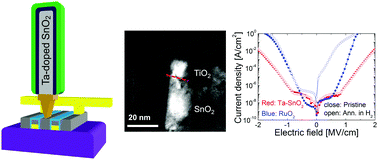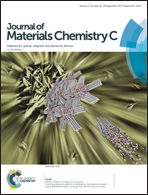Ta-Doped SnO2 as a reduction–resistant oxide electrode for DRAM capacitors
Abstract
Noble metal oxides, such as RuO2, have received attention as capacitor electrodes in dynamic random access memories (DRAMs). Noble metal oxides generally have a high work function compared to noble metals and enhance the crystallinity of dielectric materials grown on them, resulting in a lower leakage current and higher dielectric constants. Despite these advantages, noble metal oxides are easily reduced during the dielectric film, such as TiO2, growth on top or by annealing under a forming gas atmosphere, degrading the capacitor performance. In this work, Ta-doped SnO2 is suggested as a potential capacitor electrode for DRAMs. Ta-Doped SnO2 films have a high work function, comparable to that of RuO2, and induce the formation of a high-temperature phase with a high dielectric constant, namely rutile TiO2, at low temperatures. More importantly, the Ta-doped SnO2 films show suitable structural and chemical stabilities, even after annealing at 400 °C under a forming gas atmosphere. RuO2 films, on the other hand, turn into a mixture of RuO2 and Ru after annealing under the same conditions. These findings suggest that Ta-doped SnO2 could serve as capacitor electrodes in next-generation DRAMs.



 Please wait while we load your content...
Please wait while we load your content...